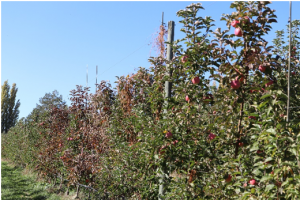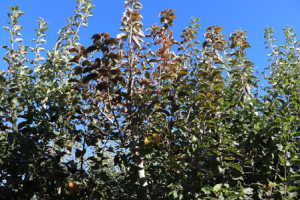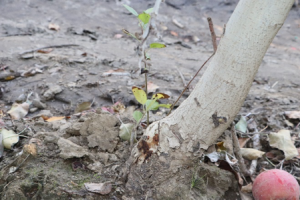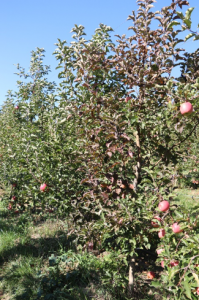Written by: Tianna Dupont, WSU Extension. Reviewed by Ken Johnson, OSU Pant Pathology. October 2018.
With fall upon us, and after the serious fire blight outbreak in Washington this year, growers are asking questions. Here we discuss some considerations for fall fire blight management.
Should I apply a fall copper spray?
Post-harvest copper has some value prior to fall flush (mid-August) to prevent new infections in pears, where harvest is early. However, as a leaf drop cover spray, copper has little value for fire blight.
Fire blight bacteria which infected blooms or young tender leaf tissue this spring or summer are inside the tree (if they have not been cut out). Copper sprayed in the fall is not known to move into the plant to cure fire blight infections that are inside the tree. Copper applied at delayed dormant in the spring is useful because it kills the cells of the fire blight bacteria as they ooze out of cankers that have overwintered. Killing bacterial cells reduces the inocula for spring infections during bloom. In the fall copper will kill bacterial cells that ooze out of cankers, but these bacterial cells are unlikely to cause infections because there is little young susceptible tissue and few flowers to infect.
Trees are starting to purple early, should trees or blocks be removed?

In the fall a few weeks before apple trees would normally start to lose their leaves, stressed trees can show purple or orange leaf color (Figure 1). This is a good time to check fire blight impacted blocks for trees that have rootstock blight. (But remember some varieties are more naturally purple going into fall).
Vigor, age and variety all impact whether trees will die from fire blight. Fire blight moves faster through young vigorous tissue. When the rootstock is more susceptible than the scion the rootstock may become infected even when the central leader of the tree appears healthy (Figure 2 and 3).
M9 and M26 rootstock are very highly susceptible to fire blight, where the rootstock can become infected while the scion trunk shows no symptoms.
Discolored leaves and early dormancy can have multiple causes including water/nutrient stress. However, fire blight is a likely cause in blocks that have had severe infections this year. To check if a disease of the rootstock is impacting trees check the base of the trees for oozing or scrape back the outer bark with a knife to see if tissue is healthy. Fire blight infected tissue may have orange or brown cambium instead of bright green. It may appear watery or spongy. It may appear dry and brown if the tissue is long dead. Symptoms can be very similar to crown and collar rot caused by Phytophthora. You may need to remove soil around the base of the tree if rootstocks are buried deeply. Remember rootstock infections may have started impacting the tree’s water and nutrient transport but not have progressed to the stage where ooze or tissue discoloration is obvious and so more trees with symptoms are likely to show up in spring.
Trees with rootstock blight should be removed either now in the fall or in the early spring. It is important to remove effected trees BEFORE bacteria in ooze can impact flowers.
Should I remove individual trees or an entire block?
Whether you remove individual trees or an entire block is an economic question dependent on your situation. It may be useful to count trees that look like they would need to be pulled as a percentage of trees in an area. For example, one orchardist may decide that when she counts 40 trees to remove out of a 325 foot row, (estimating 12% loss of trees in the block) that the patchiness to the block is tolerable and another may not.
Additional Resources
Fire Blight An overview at treefruit.wsu.edu
Organic Fire Blight Management in the Western United States
Phytophthora Crown and Collar and Root Rot of Apple and Cherry
Decision Aid System Visit for the recent model projections of blossom blight risk at your site.
Crop Protection Guide Crop Protection Guide recommendations are updated on an annual basis.
Dealing with Fire Blight Once it is in the Orchard. WSU Newsletter article July 2017.
Tips for Using Blossom Protect WSU Newsletter article April 10, 2017.
Remember last year’s infections are this year’s risk. WSU Newsletter article April 2018.
Canker Management WSU Newsletter article February 2017.
Contact
WSU Extension
tianna.dupont@wsu.edu





